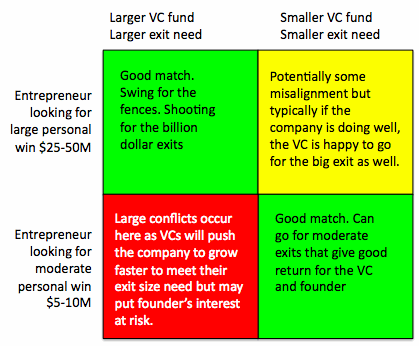In the matrix, the green represents good alignment, the yellow represents ok but keep watch, and the red represents where I see some of the larger disagreements. The matrix explains the basic situation for all 4 combinations so I’ll just focus on the yellow and red areas as the green areas are fairly self-explanatory and straightforward.
Yellow – Smaller VC fund, Smaller exit need, Entrepreneur looking for large personal win $25-50M. While there is some misalignment here, this is actually a less common situation and often doesn’t become an issue in practice. The reasons are that many entrepreneurs looking for big exits often have already had one hit and have plenty of personal funds. They often use their own money to self-fund the business initially and often don’t need a small amount of outside money but go straight for a much larger Series A from a larger VC. In addition, even for smaller funds who do invest early with these entrepreneurs, if the company is doing very well, those investors are happy to bring in larger VC syndicate partners who have deeper pockets and can fund to a much larger exit. The smaller VC will get a good bump in valuation and is happy to leverage their investment to go for the big exit that the entrepreneur and new VC seek.
Red – Larger VC fund, Larger exit need, Entrepreneur looking for moderate personal win $5-10M. This is where I see the most misalignment, conflicts between VC and entrepreneur, and the primary focus of this post. The conflict occurs in many different situations – whether a company is doing well or not. When companies are doing well, they often have opportunities to exit earlier from incoming acquisition offers. For an entrepreneur who has an opportunity to exit a company at $50M and thereby allowing the entrepreneur to personally make more than $5-10M, this often isn’t big enough to interest the VC who can block the exit and push the company to go for higher exit size (but often a much higher risk to the company). Other areas that this occurs is when determining whether to grow/expand quickly vs getting to profitability. For an entrepreneur to reach his objective, slower growth but getting to profitabilty faster can be the best option, but for the VC, growth over profitability is often the objective thereby require more spend and often leading to more financing rounds diluting the entrepreneur….and these disagreements occur when the company is doing well so generally everyone is happier and want to work together. The misalignment get much more contentious when the company is not doing as well.
Given the varied perspectives of different VCs and entrepreneurs, founders should make sure they understand this dynamic (as the VC will definitely be experienced and understand this well).



Jim – LOL and spot on. Build something good and they’ll find you or better yet, you may never need them.
I now believe it is possible to over-discuss nearly every topic, particularly when it’s the fetish entrepreneurs have with analyzing “investors”